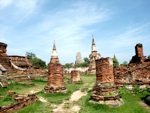

AYUTTHAYA TOUR
AYUTTHAYA TOUR
Departure: every Sunday
Departure time from Pattaya at 06:00 am. First visit will be at Bang Pa In, the former summer place of King Rama 5 who was leading the country at it's most prosperous time. Proceeding to Wat Pha Nan Choern by boat and then to Wai Yai Chaimongkol, a temple of great victory which was built by King Naresuan to commemorate his victory over Prince of Burma n 1592 AD. The next temples that we will visit is Wat Mahathat and Wat Rachaburana which is the cremation site of two Princes who were both killed on elephant back duel fighting each other for the throne. Afterwards we will proceed to Wat Sisanpet the formor temple and palace burnt in 1767 AD. The last temple that we will visit is Wat Napramain the only temple that was not destroyed by the Burmese War. Lunch will be served in a restaurant nearby.
Price: 2300 Baht per person.
Tour includes lunch & entrance fee.
Ayutthaya Informations
The Siamese state based at Ayutthaya in the valley of the Chao Phraya River grew from the earlier kingdom of Lopburi, which it absorbed, and its rise continued the steady shift southwards of the centre of gravity of the Tai-speaking peoples. U Thong was an adventurer allegedly descended from a rich Chinese merchant family who married royalty. In 1350, to escape the threat of an epidemic, he moved his court south into the rich floodplain of the Chao Phraya. On an island in the river he founded a new capital, which he called Ayutthaya, after Ayodhya in northern India, the city of the hero Rama in the Hindu epic Ramayana. U Thong assumed the royal name of Ramathibodi (1350-69).
Ramathibodi tried to unify his kingdom. In 1360 he declared Theravada Buddhism the official religion of Ayutthaya and brought members of a sangha, a Buddhist monastic community, from Ceylon to establish new religious orders and spread the faith among his subjects. He also compiled a legal code, based on the Indian Dharmashastra (a Hindu legal text) and Thai custom, which became the basis of royal legislation. Composed in Pali -- an Indo-Aryan language closely related to Sanskrit and the language of the Theravada Buddhist scriptures -- it had the force of divine injunction. Supplemented by royal decrees, Ramathibodi's legal code remained generally in force until the late nineteenth century.
By the end of the fourteenth century, Ayutthaya was regarded as the strongest power in southeast Asia, but it lacked the manpower to dominate the region. In the last year of his reign, Ramathibodi had seized Angkor during what was to be the first of many successful Thai assaults on the Khmer capital. The policy was aimed at securing Ayutthaya's eastern frontier by preempting Vietnamese designs on Khmer territory. The weakened Khmer periodically submitted to Ayutthaya's suzerainty, but efforts to maintain control over Angkor were repeatedly frustrated. Thai troops were frequently diverted to suppress rebellions in Sukhothai or to campaign against Chiang Mai, where Ayutthaya's expansion was tenaciously resisted. Eventually Ayutthaya subdued the territory that had belonged to Sukhothai, and the year after Ramathibodi died, his kingdom was recognized by the emperor of China's newly established Ming Dynasty as Sukhothai's rightful successor.
The Thai kingdom was not a single, unified state but rather a patchwork of self-governing principalities and tributary provinces owing allegiance to the king of Ayutthaya under the mandala system. These states were ruled by members of the royal family of Ayutthaya who had their own armies and warred among themselves. The king had to be vigilant to prevent royal princes from combining against him or allying with Ayutthaya's enemies. Whenever the succession was in dispute, princely governors gathered their forces and moved on the capital to press their claims.
During much of the fifteenth century Ayutthaya's energies were directed toward the Malay Peninsula, where the great trading port of Malacca contested its claims to sovereignty. Malacca and other Malay states south of Tambralinga had become Muslim early in the century, and thereafter Islam served as a symbol of Malay solidarity against the Thais. Although it failed to make a vassal state of Malacca, Ayutthaya continued to control the lucrative trade on the isthmus, which attracted Chinese traders of specialty goods for the luxury markets of China.
Ruins of the old city, Ayutthaya, after the Burmese invasion.In 1767, Burma invaded Siam, totally destroying Ayutthaya and ending the era of the proud nation of Siam. It was one of many invasions throughout the history of Siam, from neighboring Burma, which was the mightiest of all in South East Asia at the time












